On this page:
Socorro County Historical Society
Socorro, New Mexico, USA
San Marcial, NM
History
Articles
San Marcial (pronounced "San Mar-SHELL" by locals) was once a bustling railroad town on the AT&SF Santa Fe line. "New Town," as it was called, was located about 25 miles south of Socorro on the west bank of the Rio Grande adjacent to Mesa del Contadero or Black Mesa. With a population approaching 2,000 after the early 1900s, it was the second largest community in Socorro County, New Mexico. Nearby and along the Rio Grande were also the ranching and farming communities of Plaza Viejo (old San Marcial), Geronimo, La Mesa, Valverde, Tiffany and Contadero.
San Marcial and nearby villages were destroyed by two massive floods along the Rio Grande, about a month apart, in 1929. The town and railroad facilities were inundated. The damage was so severe, the Santa Fe Railroad announced it would not rebuild and located their maintenance facilities and employees to El Paso, TX, Albuquerque, and Belen, NM. Without the railroad and its $20,000 per month payroll, there was no town. San Marcial collapsed into the flood waters over several months and was never rebuilt.
A few of the old Hispanic pioneer families in the area, and a few other hearty souls, remained to rebuild their homes, farms and ranches, though the San Marcial townsite remained abandoned. After several years of hardwork, Plaza Viejo, Geronimo, and Valverde once again had homes and working farms and ranches. La Mesa and Tiffany remained abandoned due to many feet of worthless flood silt covering those former townsites. Still, less than 200 people claimed the San Marcial region home.

San Marcial – Brief History
Tragedy struck again in 1937 as another destructive flood roared down the Rio Grande, submerging Plaza Viejo, Geronimo, Valverde,
and the surrounding agricultural lands. With Elephant Butte reservoir now filled to capacity, portions of the San Marcial area remained
under flood waters for over a year. There was simply nothing left to salvage.
Due to advanced warnings of the arriving floods by the
railroad telegraphers, people had time to flee. Due to this, there are no known fatalities associated with the flood – though horrific
destruction. After the 1937 flood, the Army Corps of Engineers declared the area untenable – meaning there were no measures that could
be taken to ensure another devastating flood would not occur. This meant the remaining residents could not obtain bank loans or insurance
policies to rebuild. As a result, the area has been abandoned ever since except for one remaining family.
The San Marcial floods completely
changed the face of Socorro County. A major railroad town and a growing commerce center, along with the area's people, mostly living
quite well with a measure of affluence, were literally wiped out overnight. Many were left homeless and destitute without the government
disaster relief programs we have today. While many families resettled in Socorro, Magdalena, or other nearby towns looking for jobs,
many never regained the "good life" and affluence they once had at San Marcial.
More history of the region
here.

Defensor Chieftain history article
by Paul Harden
History of San Marcial and the destructive 1929 and 1937 floods
San Marcial history, why AT&SF chose San Marcial for its major maintenance facilities, railroad operations, and the 1929 flood.
A research report by several
SCHS members on the history of the AT&SF operations, photos, maps, and today's remnants.
By Paul Harden with James Taylor
The 1892 robbery of the San Marcial bank and the deadly trail to capture the outlaw robber.
Defensor Chieftain history article
by Paul Harden
San Marcial and surrounding areas are part of the Armendaris Land Grant. History of the land grant to the present day Ted Turner's Armendaris ranch.

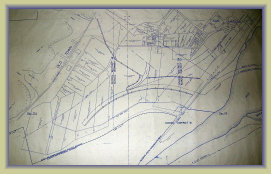
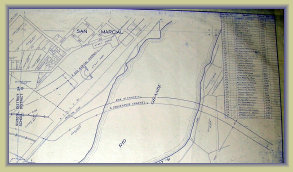
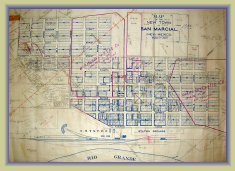
Click maps to enlarge
Links:
Location of San Marcial
features on a modern
topo map
Map 1 (southern half)
Map 2 (northern half)
1920s Middle Rio Grande Conservancy District maps of San Marcial
1927 San Marcial street and land ownership map
(prior to the flood)
0510/20b
Photos and information on the San Marcial cemeteries:
• Masonic Cemetery
• Catholic Cemetery
• Gonzales/Plaza Viejo cemetery
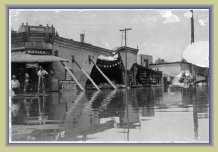
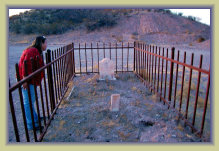
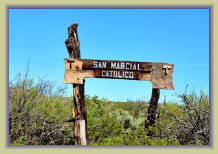
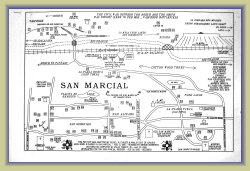
Benigno "Bennie" Barreras
1995 San Marcial Reunion Map
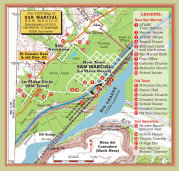
The Archive Clearinghouse for San Marcial, NM Information and Photos
San Marcial, a railroad town of about 2,000 people, was destroyed by floodwaters in 1929, forcing its abandonment. It is no
more. There is little available information on this chapter of New Mexico history. The Socorro County Historical Societyis proud to present the largest collection of information and photos on the history of San Marcial, thanks to local research, field
work, interviews with descendents, and the donation of photos by former San Marcial families to keep the memories alive.
San
Marcial includes the communities of New Town San Marcial, Old Town San Marcial (Plaza Viejo), San Geronimo, La Mesa, Tiffany,
Valverde and Contadero.
By Dr. Peggy Hardman
The interesting story of who is buried in that solitary grave at San Marcial, and why.










